
As September rolls in, it’s the perfect time to transform your orchard into a beautiful apple harvest garden. First, think about the apple varieties that grow best in your area, as this will help your trees thrive. Pairing different plants together, known as companion planting, not only boosts plant health but also makes your garden a nice home for bees and butterflies.
Designing charming pathways can add extra beauty to your orchard. Excited to learn about sustainable gardening practices that involve your friends and family? Let’s dive into creative ideas that make your apple harvest garden not just a pretty space, but also a welcoming place for nature and your community!
—
Welcome to Your Apple Harvest Garden! As September approaches, there’s no better time to turn your orchard into a vibrant apple harvest garden. Choosing the right apple trees for your local climate will help ensure healthy and delicious apples for you to enjoy.
Engage Your Community with Nature By using companion planting techniques, you’ll create a fun environment that attracts helpful pollinators like bees. Plus, adding lovely pathways can make your orchard even more inviting for family and friends. Get ready to embark on a sustainable gardening journey!
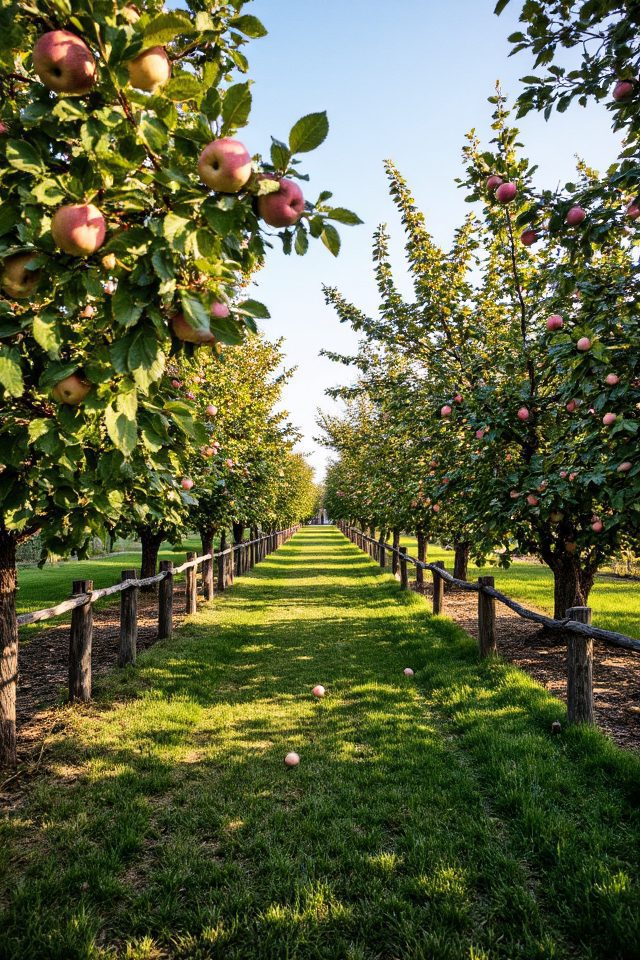
Choosing the right apple varieties for your climate is essential for a successful orchard garden. Different apple trees thrive in specific conditions, including temperature, humidity, and soil type.
For warmer climates, consider heat-tolerant varieties like ‘Granny Smith’ or ‘Fuji,’ while cooler regions may favor ‘Honeycrisp’ or ‘Gala.’
Researching local growing conditions and frost dates can help you select varieties that will flourish, yield abundant fruit, and resist common diseases in your area.
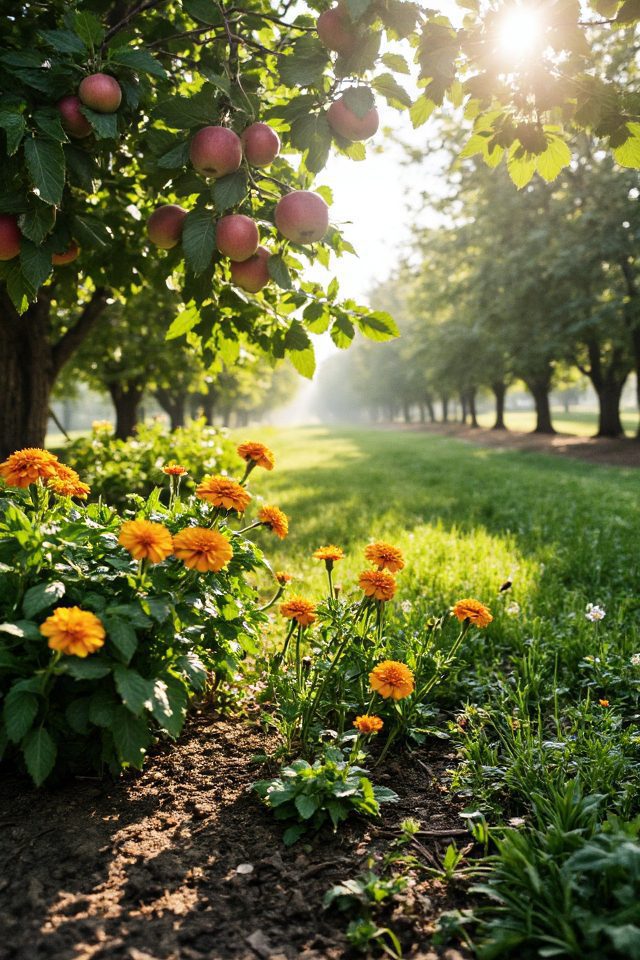
Implementing companion planting in your orchard garden can considerably enhance pest control while promoting healthier plants. By strategically pairing certain plants together, you can deter harmful insects and attract beneficial ones.
For example, planting marigolds near fruit trees can repel aphids, while basil planted alongside apple trees can ward off pests and enhance the flavor of the fruit.
This natural pest management technique not only reduces the need for chemical interventions but also encourages biodiversity and soil health.
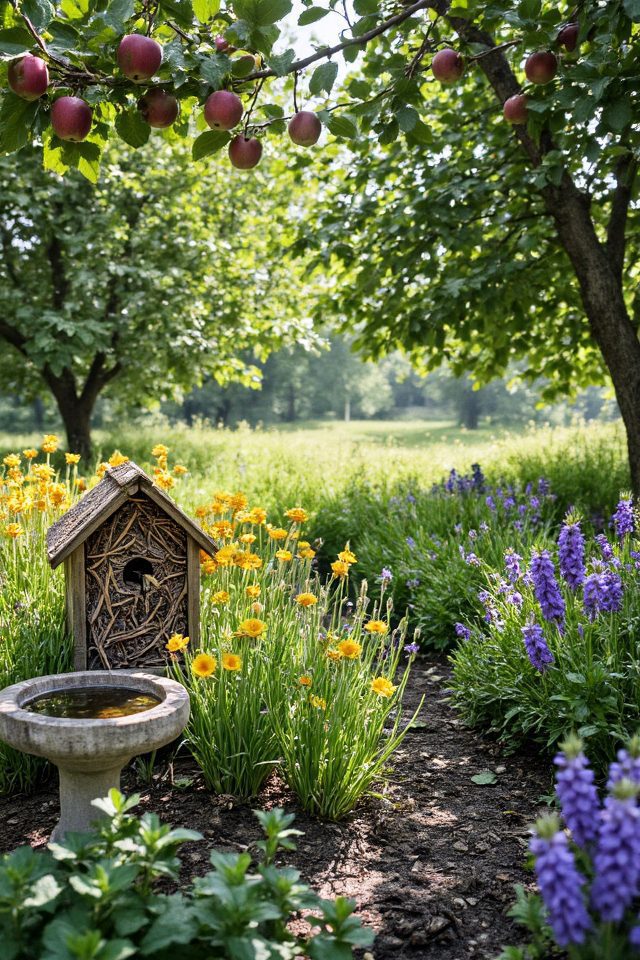
Creating a pollinator-friendly environment in your orchard garden is crucial for boosting biodiversity and fostering a thriving ecosystem.
Incorporating a variety of flowering plants, such as wildflowers, herbs, and native species, will attract bees, butterflies, and other beneficial insects.
Additionally, providing habitats like insect hotels and brush piles can support these pollinators year-round.
Avoiding harmful pesticides and offering clean water sources will further guarantee a safe haven for these important creatures, enhancing fruit production and garden health.
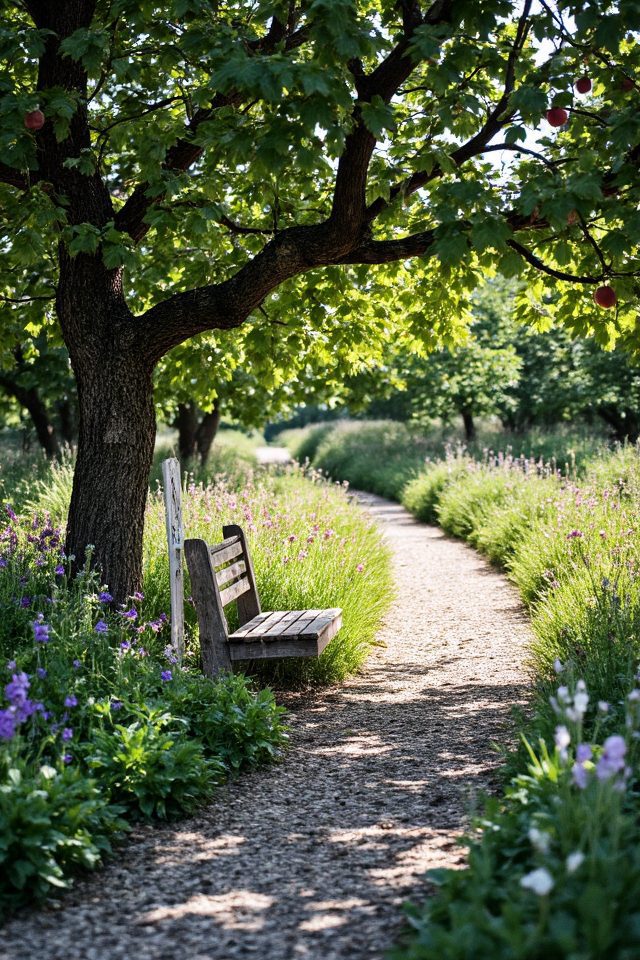
Designing decorative orchard paths can transform a functional space into a picturesque retreat. Start by choosing materials that complement the natural environment, such as gravel, wood chips, or stone.
Incorporate gentle curves to create a sense of flow, guiding visitors through the orchard. Enhancing the paths with flowering plants or low-growing herbs along the edges adds color and aroma.
Consider installing rustic benches or whimsical markers to invite pause and enjoyment, making the orchard not just a source of fruit, but also a serene escape.
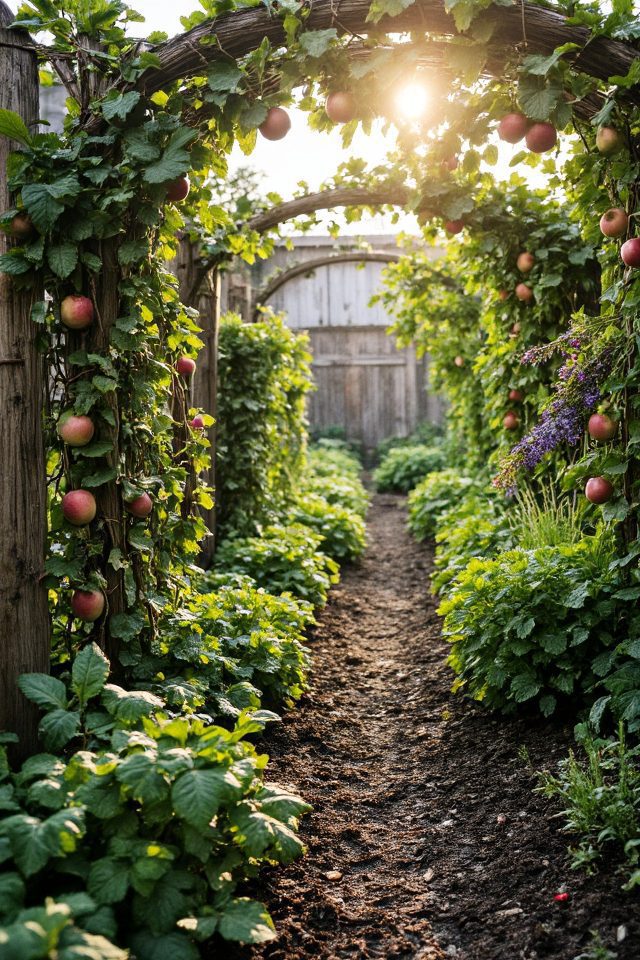
Vertical gardening techniques are a fantastic way to maximize space in your orchard garden while adding visual interest.
By using structures like trellises, wall planters, and vertical frames, you can grow a variety of plants, such as fruits, vegetables, or herbs, upward rather than outward.
This not only saves ground space but also improves air circulation and accessibility, making it easier to care for your plants.
Additionally, vertical gardening can create a lush, green aesthetic that enhances your garden’s appeal.
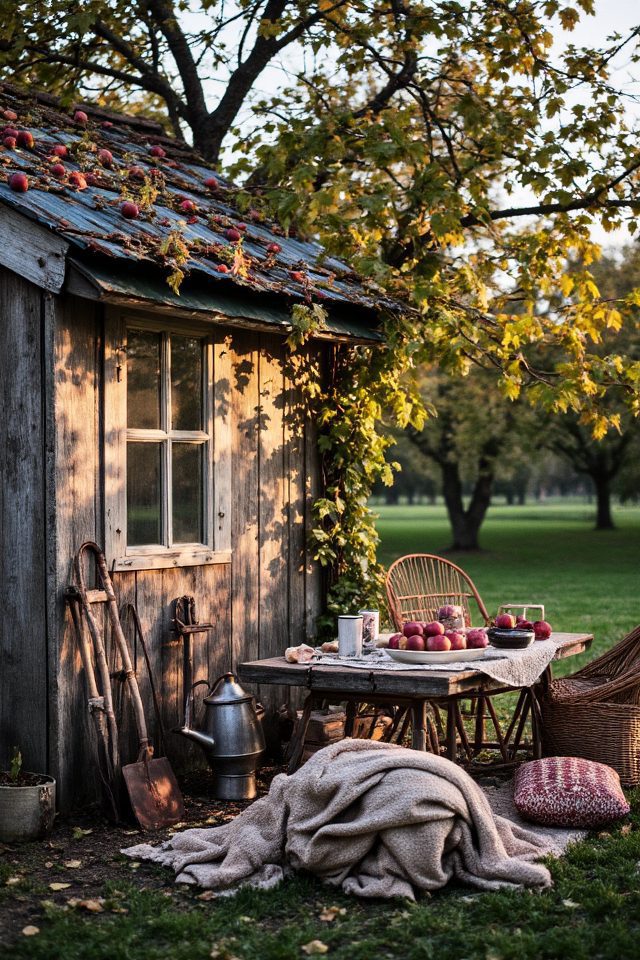
Building a cozy harvest hut in your orchard can create a charming space for relaxation and storage.
This rustic retreat can be constructed using reclaimed wood and adorned with vintage tools for a nostalgic touch.
Equip it with comfortable seating, soft cushions, and gentle lighting to enhance the atmosphere.
Use the hut to store your harvest or enjoy peaceful moments among the trees, making it an inviting focal point for gatherings with family and friends.
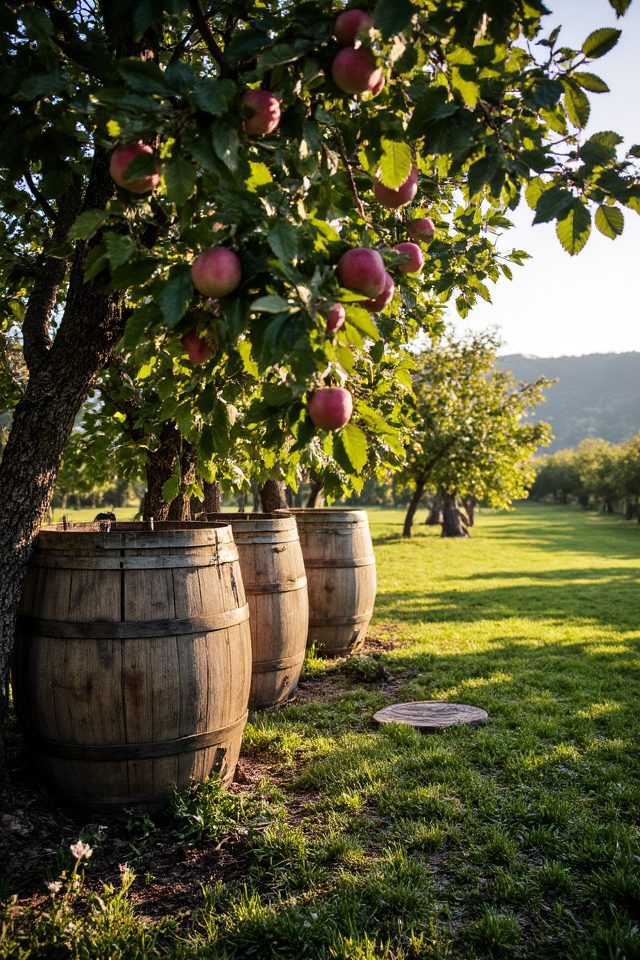
Installing rainwater harvesting systems in your orchard garden is a sustainable way to collect and utilize natural precipitation. By capturing rainwater from roofs and surfaces, you can create a reservoir for irrigation during dry spells.
This not only conserves water but also reduces runoff and erosion. Implementing such systems can promote healthier plants, enhance soil moisture, and provide an eco-friendly approach to orchard management.
Consider using barrels or underground cisterns to store collected rainwater effectively.
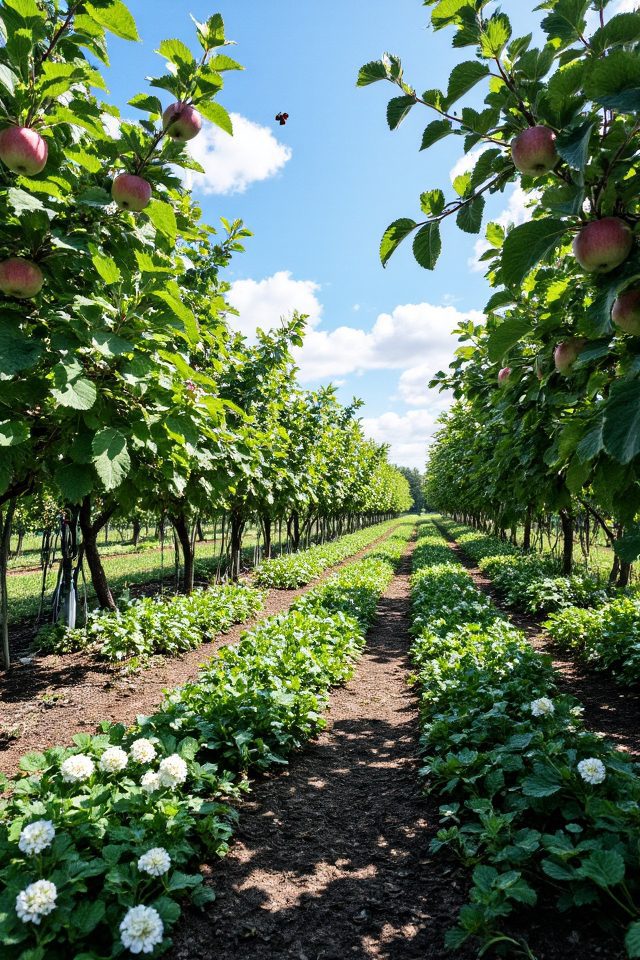
Intercropping is a sustainable practice that involves planting two or more crops in proximity for mutual benefit. This technique can enhance biodiversity, improve soil health, and minimize pests naturally.
For your orchard garden, consider pairing fruit trees with nitrogen-fixing plants, like clover or beans, to enrich the soil.
Additionally, intercropping can create a layered effect, maximizing space and yielding more produce while fostering a vibrant ecosystem.
Experimenting with this method can lead to a flourishing, productive garden.
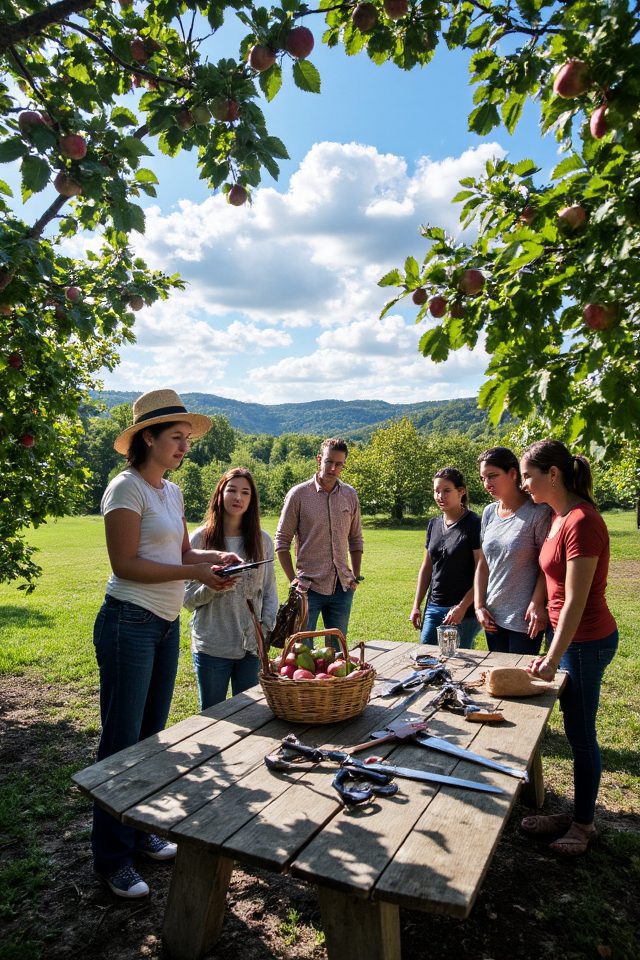
Incorporating fruit tree pruning workshops into your orchard garden plans can greatly enhance the health and productivity of your fruit trees.
These hands-on sessions educate participants on essential pruning techniques, ensuring trees receive proper sunlight and air circulation.
By mastering the art of pruning, attendees will learn to promote better fruit yield and manage tree shape effectively, leading to a thriving orchard.
Plus, these workshops foster community engagement and share valuable gardening knowledge among local enthusiasts.

Hosting apple-picking events in your orchard can attract visitors and create lasting memories.
Organize seasonal events where families can wander through the trees, hand-picking their favorite varieties of apples.
Enhance the experience by offering guided tours, educational sessions on apple cultivation, and fun activities for children, such as hayrides and corn mazes.
Complement the day with local food stalls and fresh apple cider to create a festive atmosphere that celebrates the harvest season.
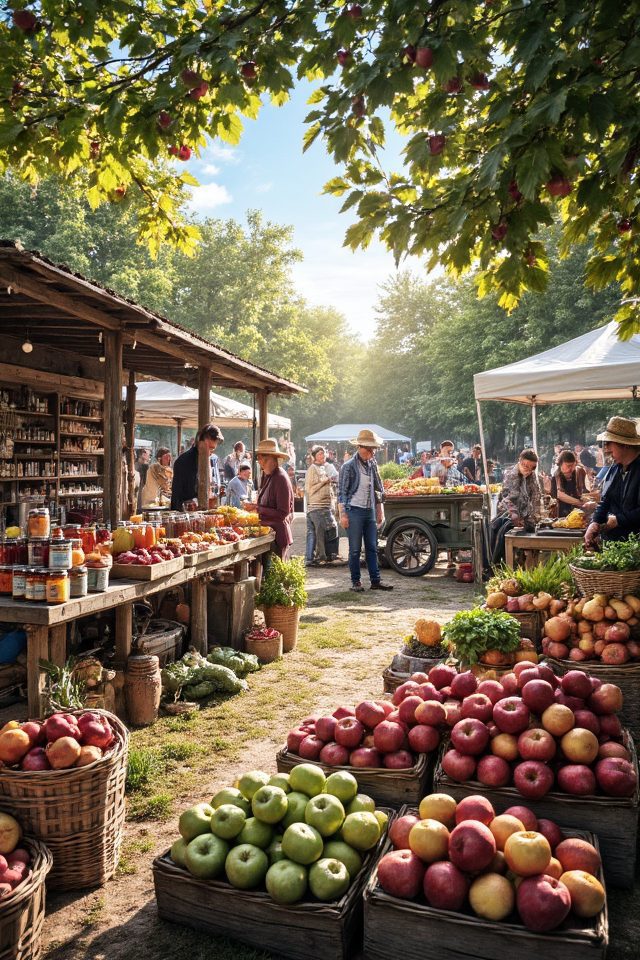
Setting up a community harvest market is an excellent way to bring neighbors together while celebrating the fruits of their labor.
Organize a designated space where local gardeners can sell or trade their excess produce, homemade jams, and baked goods. Incorporate activities like cooking demonstrations, gardening workshops, and live music to create a festive atmosphere.
This not only promotes sustainable practices but also fosters a sense of community, encouraging healthier eating and stronger local connections.
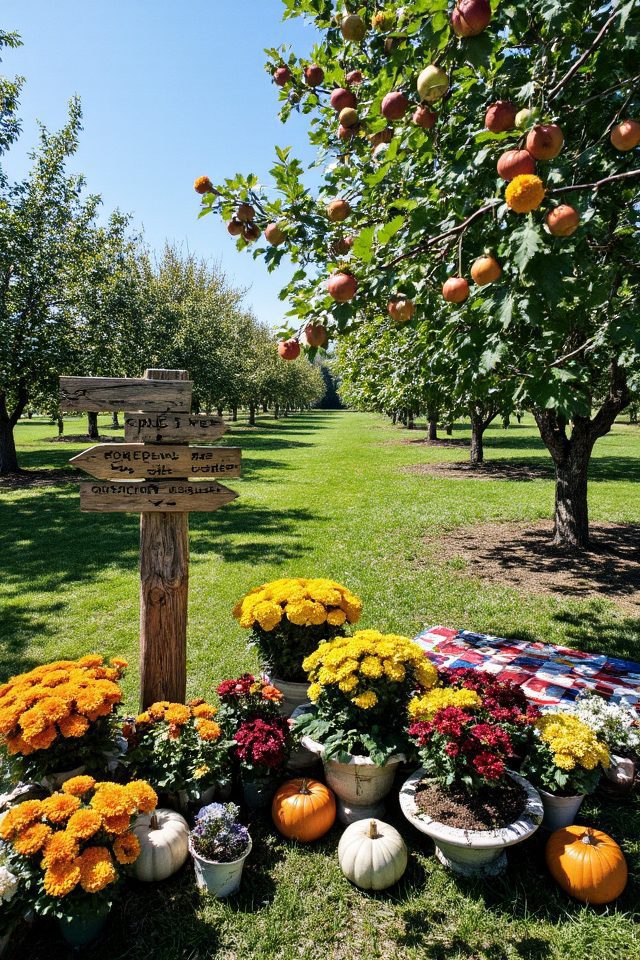
Creating stunning seasonal displays in your orchard garden can transform the space throughout the year.
Begin by incorporating a variety of flowers that bloom in different seasons, such as daffodils in spring, sunflowers in summer, and chrysanthemums in fall.
Use decorative elements like colorful pots, whimsical garden ornaments, and seasonal decorations like pumpkins or festive lights.
Layering textures with foliage and fruits adds depth, ensuring your orchard always looks inviting and vibrant, celebrating the beauty of each season.
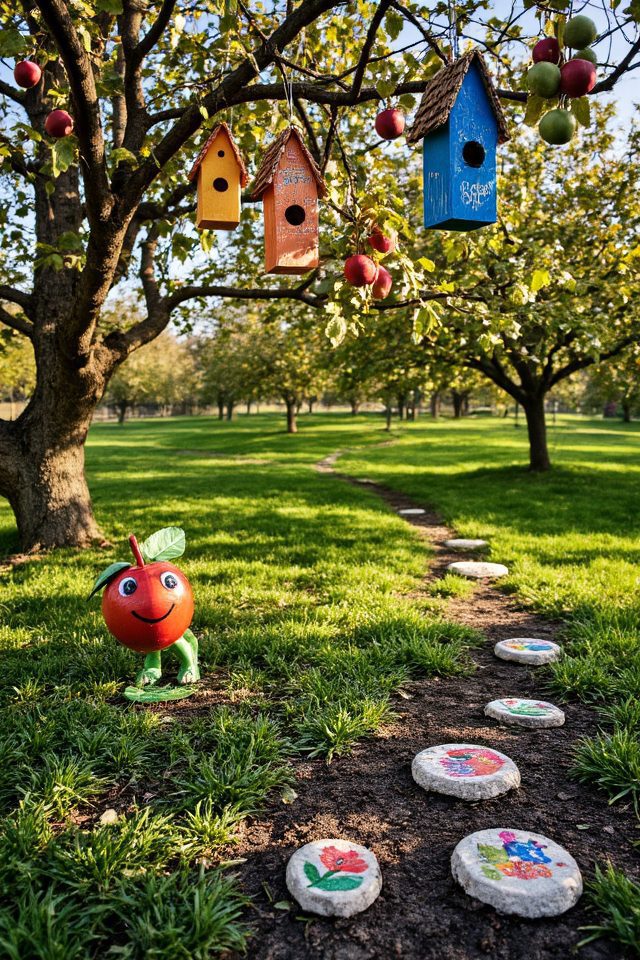
Integrating DIY garden art into your orchard can add a unique and personal touch to the space.
Consider creating colorful birdhouses, whimsical sculptures, or painted stepping stones that reflect your personality and taste. Use natural materials like wood, stone, or repurposed items to maintain an organic feel.
These artistic elements not only enhance the aesthetic appeal of your garden but also provide character and charm, making your orchard a delightful retreat for both you and your visitors.
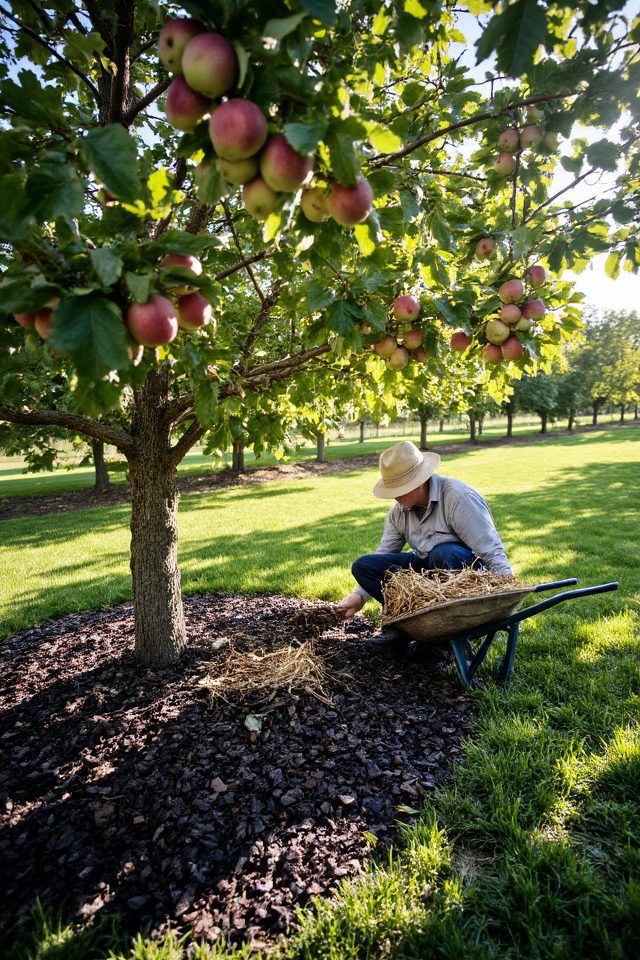
Establishing a mulching routine is essential for maintaining a healthy orchard garden.
Mulch helps retain soil moisture, suppresses weeds, and adds organic matter as it breaks down. To start, choose organic materials like wood chips, straw, or leaf mold.
Apply a layer of 2-4 inches around the base of your trees, ensuring not to contact the trunk directly. Regularly refresh the mulch every season to enhance nutrient availability and promote a thriving environment for your fruit trees.
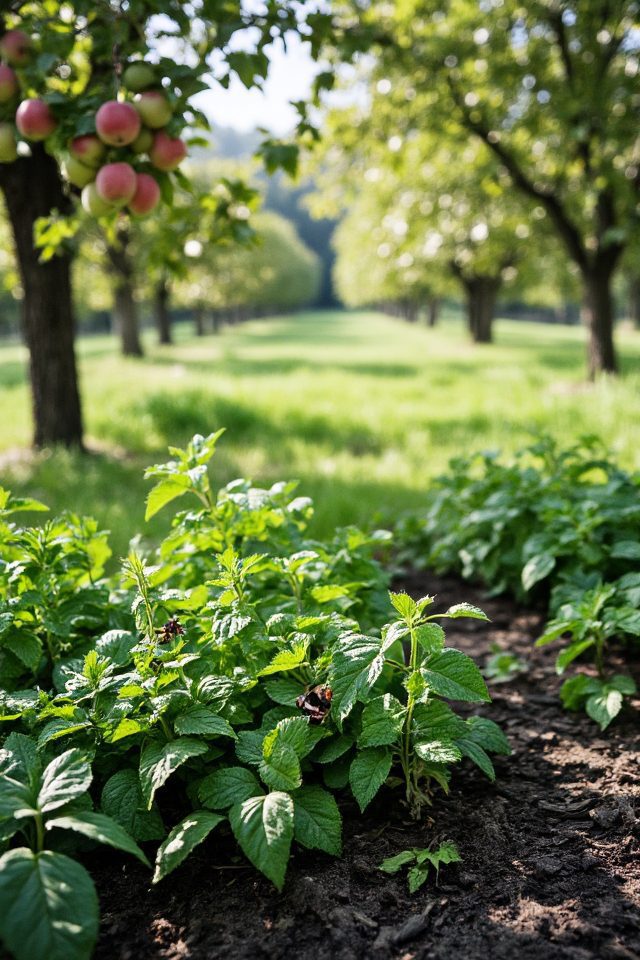
Growing herbs alongside apple trees can enhance the health and flavor of your fruit. Herbs such as basil, mint, and rosemary not only repel pests but also attract beneficial insects that promote pollination.
Their natural oils can improve soil health and provide nutrients as they decompose. Plus, having fresh herbs at hand while enjoying the apples adds a delightful culinary touch to your orchard garden.
Create a harmonious ecosystem that nurtures both your apple trees and your herb garden!
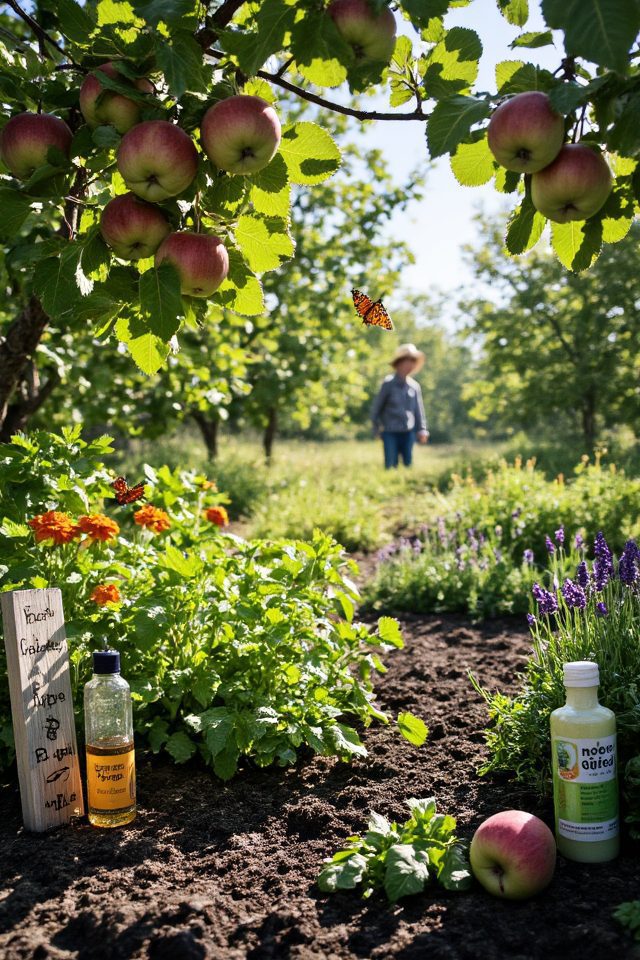
Sustainable pest management in an orchard garden emphasizes ecological balance while protecting plants from pests.
Implementing practices such as crop rotation, companion planting, and the use of beneficial insects can considerably reduce pest populations.
Integrating natural deterrents, like neem oil or garlic spray, further enhances this approach.
Regular monitoring and maintaining healthy soil are essential for promoting resilience in plants, ultimately leading to a thriving and sustainable orchard ecosystem.
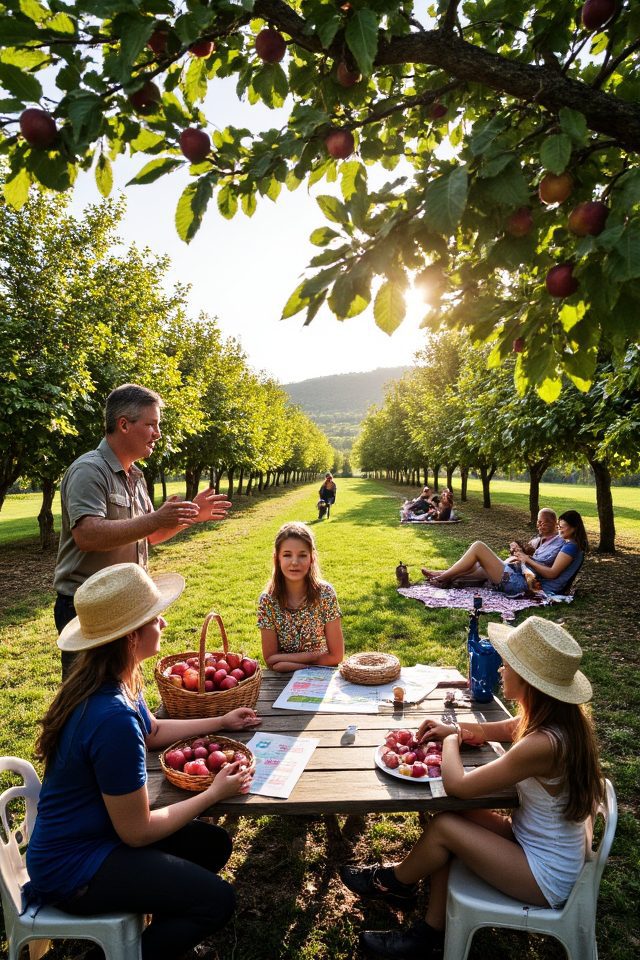
Organizing educational orchard tours is a fantastic way to engage the community and promote awareness about sustainable agriculture.
These tours can provide participants with hands-on learning experiences about different fruit varieties, pollination processes, and organic farming practices. Incorporating informative sessions led by experienced growers can enhance the tour, while activities such as fruit picking or tree planting foster a deeper connection to the land.
This approach not only supports local ecosystems but also encourages healthy eating habits.
By embracing these apple harvest garden ideas, you’re not just enhancing your orchard; you’re cultivating a vibrant ecosystem that supports biodiversity and community engagement. Each sustainable practice, from companion planting to organizing educational tours, contributes to a thriving, productive environment. Your efforts will not only yield delicious apples but will also foster connections within your community, educate visitors, and promote long-term environmental stewardship. Transform your orchard into a haven where nature and community flourish together.

Don't let aphids, slugs, and caterpillars ruin another plant. Take back control with simple, natural methods that actually work.